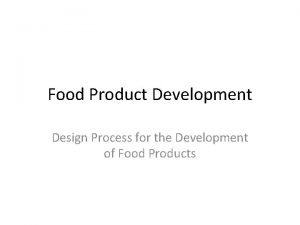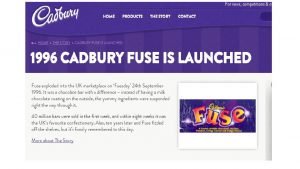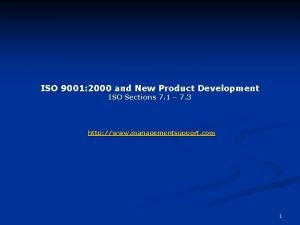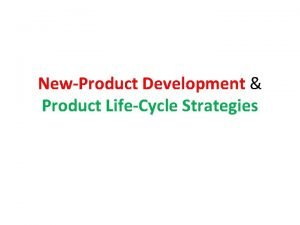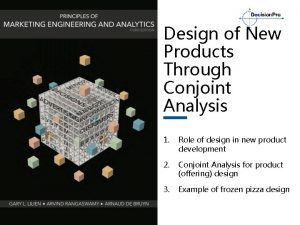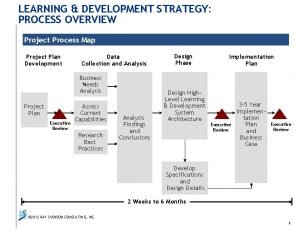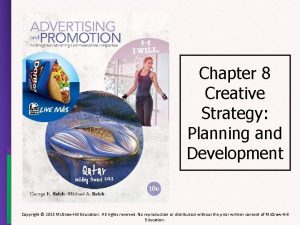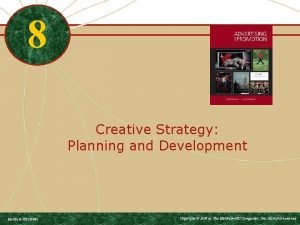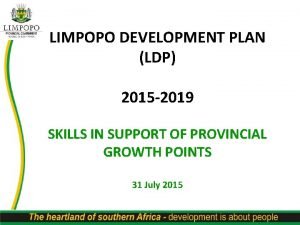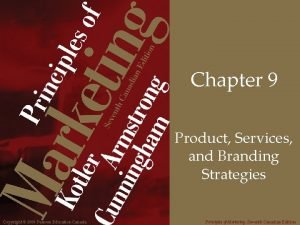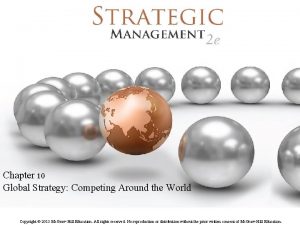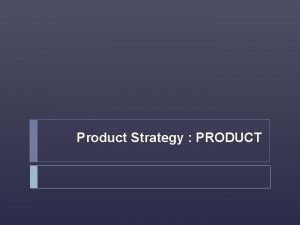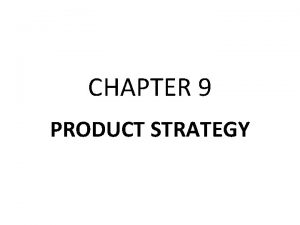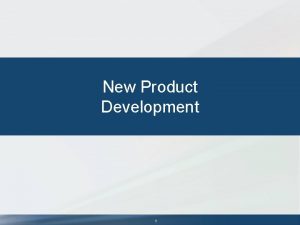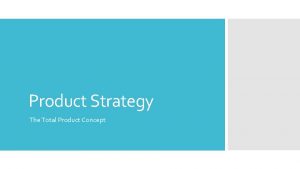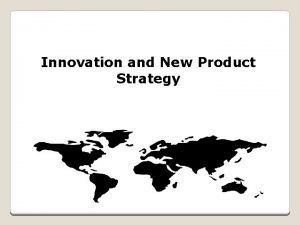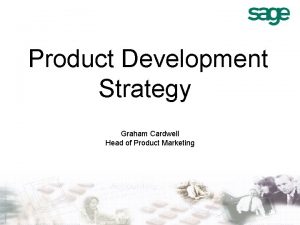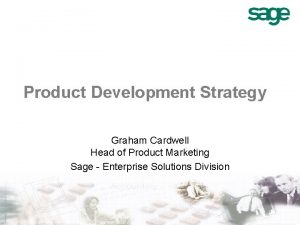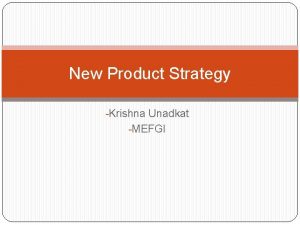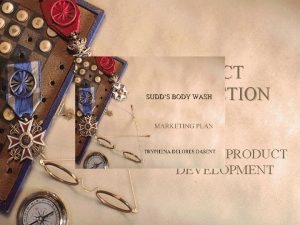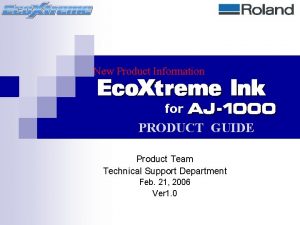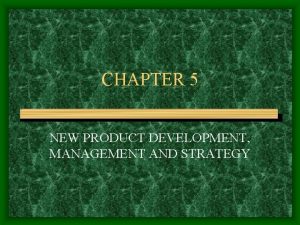CH 9 PRODUCT STRATEGY AND NEW PRODUCT DEVELOPMENT


































- Slides: 34

CH 9 PRODUCT STRATEGY AND NEW PRODUCT DEVELOPMENT

INTRODUCTION Formation of marketing mix strategy is the 4 th key element in the marketing planning process. this involves determining how the marketing mix will be used.

IMPORTANCE OF PRODUCT Product is a key element in the marketing mix because: 1. IT’S THE FIRM’S REASON FOR BEING- all firms are in the business of satisfying customer needs (through the product) 2. ALL OTHER ELEMENTS OF THE MARKETING MIX REVOLE AROUND THE PRODUCT- their role is to facilitate market acceptance of the product.

DISTRIBUTION STRATEGY- makes the product available, where and when the market wants it PRICING STRATEGY- makes the product available at a price that is attractive to the market and profitable to seller. PROMOTION STRATEGY- communicates to the market the potential benefits of the product (based on it design, distribution and price attributes)

WHAT IS A PRODUCT? Kotler: “a product is anything that can be offered to the market for attention, acquisition, use, or consumption that might satisfy a want or need. All banking services are considered products. From a marketing point of view, products have 5 aspects: 1 -core product(benefit) 4 -augmented product 2 -generic product 5 -potential product 3 -expected product

1 -CORE PRODUCT(BENEFIT)- is the essential benefit that the customer is buying 2 -GENERIC PRODUCT- provides that benefit 3 -EXPECTED PRODUCT- product features customers assume will be part of the product. 4 -AUGMENTED PRODUCT- specific features and benefits that help differentiate the product from its competitors. Bank products are augmented by the level and quality of service provided and the reputation of the bank 5 -POTENTIAL PRODUCT- all the modifications the product might undergo in the future

PRODUCT ITEM, PRODUCT LINE AND PRODUCT MIX PRODUCT ITEM- a specific version of a product PRODUCT LINE- a group of closely related products PRODUCT MIX- full range of products offered for sale by the bank/firm Product mix has 2 characteristics: 1. breadth- number of different product lines in the mix 2. Depth- number of product items within each product line.

SERVICES VS PRODUCTS SERVICE- any act/performance that one party offers another, its essentially intangible and doesn’t result in the ownership of anything. Service industries: health care, transport, education and banking Services have characteristics that create problems for marketers, therefore marketing a service is very different from marketing products

SERVICE CHARATERISTICS 1. INTANGIBILITY- services cant be experienced by the senses. Customers cant shop for a service how they would for a product. In the prepurchasing stage, service marketer must compensate for customer’s inability to physically examine the product by providing evidence of the quality of their service by building a reputation for reliability in delivering the principal benefits of the services. Some marketers try to overcome intangibility issues by identifying the service with a tangible symbol.

2. INSEPARABILITY- services cant be separated from the person selling/delivering the service. The core product in banking is the relationship between the customer and bank teller. This relationship is an important channel in distribution- inseparability characteristic. 3. VARIABILTY- augmented products of a bank aren’t identical from branch to branch. No service business can have precisely the same standard of service in every outlet at every moment. (opposite to mass produced products). Because of the difficulty of standardising services, its important to set measurable standards for quality services.

4. PERISHABILITY- services are highly perishable since they cant be stored. Plus demand for the fluctuates considerably by season, day or hour. The combination of perishability and fluctuating demand presents challenges for marketers engaged in product planning, pricing, promotion and distribution in service industries.

PRODUCT STRATEGIES Fall into 2 categories: 1 - strategies related to product mix 2 - strategies related to product life cycle PRODUCT MIX STRATGIES: 1 -product expansion 4 -product repositioning 2 -product contraction 5 -trading up/down 3 -product modification

1 -PRODUCT EXPANSION- adding new products to existing product line- deepens the product line/adding new product lines to existing product mix- broadens product mix. 2 -PRODUCT CONTRACTION- thinning out product line by eliminating products/eliminating entire product lines that contribute little profit. Done to concentrate resources on a narrower product mix that will generate more profits. 3 -PRODUCT MODIFICATION- improve the product/ redesign/repackage it to increase sales. Continually altering products to respond to changing consumer Preferences.

4 -PRODUCT REPOSITIONING- done to set their products apart from their competitors’. Banks reposition themselves as result or mergers and acquisitions. 5 -TRADING UP TRADING DOWN- closely related product expansion strategies based on the allure of prestige. Trading up- adding higher priced/prestige items to product line in hope to attract customers for its lower priced items as well. Trading down- adding lower priced items to a prestige line in hope to attract people to buy lower priced items.

PRODUCT LIFE CYCLE STRATEGIES Shows the pattern of sales and profits at each stage in the cycle. Some products enter the market, take off quickly and die off just as fast. Others revive after the decline phase (double humped camel life cycle) Product life cycle has 4 stages: 1 -introduction 3 -maturity 2 -growth 4 -decline

1 -INTRODUCTION- characterised by slow growth in sales as the product is introduced and the market gradually becomes aware of it. Here profit curve shows a loss because of heavy expenses incurred plus; research and development costs, cost of distribution system to deliver product to the market and advertisement expense to make consumers aware of it. Length of introductory stage depends on the rate at which consumers accept the product.

2. GROWTH- characterised by acceleration in sales as more people become aware and buy the product. Increased sales attracts competition to enter the market. Until they do so, firm that introduced the product has an edge in increasing market- ideal situation. These allow for the product to quickly become profitable. 3. MATURITY- profitability of product in growth stage attracts intense competition as maturity stage approaches. Its characterised by slowed rate of sales growth (most prospective buyers have already purchased the product) and aggressive advertising, which increases costs and reduces profit.

5. DECLINE- total sales of a product take a marked downturn. Regular savings accounts are in this stage. Decline in sales may be caused by any number of forces, including a new product to replace the existing one. Things that may be responsible for triggering a dramatic decline in product sales: Technological innovation, federal regulations, social changes. This phase is characterised by reduced production, reduced promotion, and restricted variety of products offered.

PRODUCT ADOPTER CATEGORIES Pattern by which customers accept and adopt new products is related to product life cycle. Response rate varies greatly. Very few try new products as soon as they are introduced, most wait a while before buying and some will never adopt the product. 5 categories of product adopters: 1. INNOVATORS- risk takers, young better educated, have higher income and social standing and their source of info is multimedia based.

2. EARLY ADOPTERS- young better educated, have higher income and social standing and their source of info is multimedia based. 3. EARLY MAJORITIES-young better educated, have higher income and social standing and their source of info is multimedia based. 4. LATE MAJORITY- limited info source and rely on reference groups to form opinions. 5. LAGGARD- limited info source and rely on reference groups to form opinions.

SYSTEMS SELLING Strategy for marketing products in the maturity phase of life cycle. Involves marketing or coordinated solutions to customers’ problem. Its based on the recognition by marketing orientated executives that customers do not buy productsthey buy solutions to problems/needs. Banks take the form of service packaging- number of services for on fee/price. Customers like them as they conveniently provide a total solution to their finanical problems.

NEW PRODUCT DEVELOPMENT Products tend to be most profitable in growth stage, large amount of firms’ product mix should be in this stage at all times. While some banks develop new products, others develop products/service delivery systems that are new to the market. These innovators are large banks with substantial research and development budget.

TYPES OF NEW PRODUCTS 1. MODIFICATION OF EXISTING PRODUCTS- new product developed by modifying an existing one. 2. EXTENSION OF A PRODUCT LINE- adding new products to the product line 3. DEVELOPMENT OF BANKING-RELATED PRODUCTS - Adding new banking related product lines to their product mix 4. DIVERSIFICATION INTO NEW PRODUCT CATEORIES - Banks extending into non-traditional banking services

NEW PRODUCT DEVELOPMENT STAGES 8 STEPS: 1. EXPLORATION AND IDEA GENERATIONconduct formal search of the market. New product ideas come from on-going research to ID customer needs that aren’t being met/from management or employees. Some firms give cash incentives to employees for generating new ideas.

2. PRODUCT SCREENING- ideas for new products must be screened against product objectives, product policy and company resources. NOT EVERY NEW IDEA SHOULD BE PURSUED. New product ideas must be evaluated to ensure it doesn’t take business away from existing products. 3. CONCEPT TESTING- is crucial. It’s a function of consumer marketing research. This is carried out by assembling a small focus group to explore their reaction to a new product(qualitative research). It can provide an insight to how the product maybe positioned/promoted.

4. BUSINESS ANALYSIS- involves developing a written business case and recommendations based on result of market analysis, production feasibility analysis, marketing strategy development, cost and revenue projections. It indicates if there’s sufficient demand for the product and shows if the product meets overall goals and objectives. 5. PRODUCT DEVELOPMENT- determines whether its feasible to produce/provide the product/service at a quantity what will make the retail price attractive to it’s customers. Here the promotion, distribution and pricing strategies are developed. This involves developing a prototype to test.

6. TEST MARKETING- test market new products in ½ geographical markets, maybe using different promotional approaches in each market. Benefits are it allows banks to assess customer response as well as familiarise employees with the planned new products. It can be expensive and time consuming, also gives competitors a chance to quickly copy the new product. 7. IMPLEMENTATION/COMMERICALIZATIONcompany commits resources to full-scale introduction off product to the market. This is expensive and risky

8. EVALUATION- involves the use of primary and secondary research to monitor the progress of new product in relation to company goals. No development plan is complete without the evaluation step. Effective monitoring enables the bank to take corrective action where needed and gain additional knowledge that will facilitate the introduction of the next new product.

PRODUCT MANAGEMENT One person is assigned overall responsibility for product/s. amount of responsibility and authority varies from bank to bank, depends on size and organisational structure. Generally responsible for developing annual marketing plans and strategies, seeing that they are carried out, tracking product’s performance and taking corrective actions when needed. Product management is becoming more popular as a way of maximising the performance of every item in the product line.

PRODUCT FAILURES Many products don’t make it past the introduction phase. Some product failures represent a weakness in 1/more elements of marketing mix. 4 reasons products fail: 1. FAILURE TO LOOK AT THE NEW PRODUCT FROM MARKET POINT OF VIEW- intuitive process tends to be disproportionally biased based in favour of own experiences, values and needs. 2. FAILURE TO RESEARCH THE NEEDS OF MARKET SEGMENT CREATIVELY- need to find unmet customer needs before developing said product.

3. FAILURE TO CONSIDER DEGREE OF BEHAVIOURAL CHANGE REQUIRED OF THE PROSPECTIVE CUSTOMER- new product requires a change in banking behaviour of customers, marketing effort must recognise this and aim to minimising customers’ psychological discomfort. 4. FAILURE TO COMMUNICATE A NEW PRODUCTS BENEFITS CLEARLY- failure to make clear its benefits to the customers want to know, “what’s in it for me? ”

PRODUCT ELIMINATION When a product dies or its profitability declines steadily, the product should be eliminated. Yet most companies and banks don’t have a well planned process for handling declining products. They pay much more attention to developing products when compared with product elimination.

BENEFITS OF PRODUCT ELIMINATION Most importantly it increases profitability. It can also improve efficiency by cutting out the dead wood. Weak products can consume important resources, eliminating them can free up resources for more promising uses. Also weak products require a lot of time to manage them. They should establish a procedure for determining under what circumstances a product should be eliminated. Regulatory changes have led to banks eliminating some products.

INDUSTRY RESISTANCE TO PRODUCT ELIMINATION 1. Droping a product may be disruptive, employees may have to be shifted or laid off. 2. Dropping a product might alienate key customers who depend on that product, affecting business with them 3. To save face, there is a tendency to take less drastic action (changing advertisement/modify pricing), even when eliminating the product is clearly warranted.
 New product development and product life cycle strategies
New product development and product life cycle strategies Product planning and development definition
Product planning and development definition Product planning and development
Product planning and development Contoh new product development
Contoh new product development New product development funnel
New product development funnel Design specifications
Design specifications New product development of cadbury
New product development of cadbury Wbs product development
Wbs product development Food product development definition
Food product development definition New product development procedure iso
New product development procedure iso Different phases of edlc in embedded system
Different phases of edlc in embedded system Strategic management
Strategic management Matt damon
Matt damon Corporate strategy vs business strategy
Corporate strategy vs business strategy Aggregate planning
Aggregate planning Strategy process map
Strategy process map Creative strategy planning and development
Creative strategy planning and development Creative strategy planning and development
Creative strategy planning and development Limpopo provincial growth and development strategy
Limpopo provincial growth and development strategy Product services and branding strategy
Product services and branding strategy Multidomestic strategy
Multidomestic strategy Global operations strategy options
Global operations strategy options Aligning hr strategy with business strategy
Aligning hr strategy with business strategy Transnational strategy vs global strategy
Transnational strategy vs global strategy Strategy executing process
Strategy executing process Strategy formulation vs strategy implementation
Strategy formulation vs strategy implementation Top-down listening strategy is a listener-based strategy.
Top-down listening strategy is a listener-based strategy. Captive company strategy
Captive company strategy Multinational strategy vs global strategy
Multinational strategy vs global strategy New york pennsylvania new jersey delaware
New york pennsylvania new jersey delaware Fresh oil new wine
Fresh oil new wine 3 weaknesses of the articles of confederation
3 weaknesses of the articles of confederation New marketing realities
New marketing realities New classical and new keynesian macroeconomics
New classical and new keynesian macroeconomics Chapter 16 toward a new heaven and a new earth
Chapter 16 toward a new heaven and a new earth





